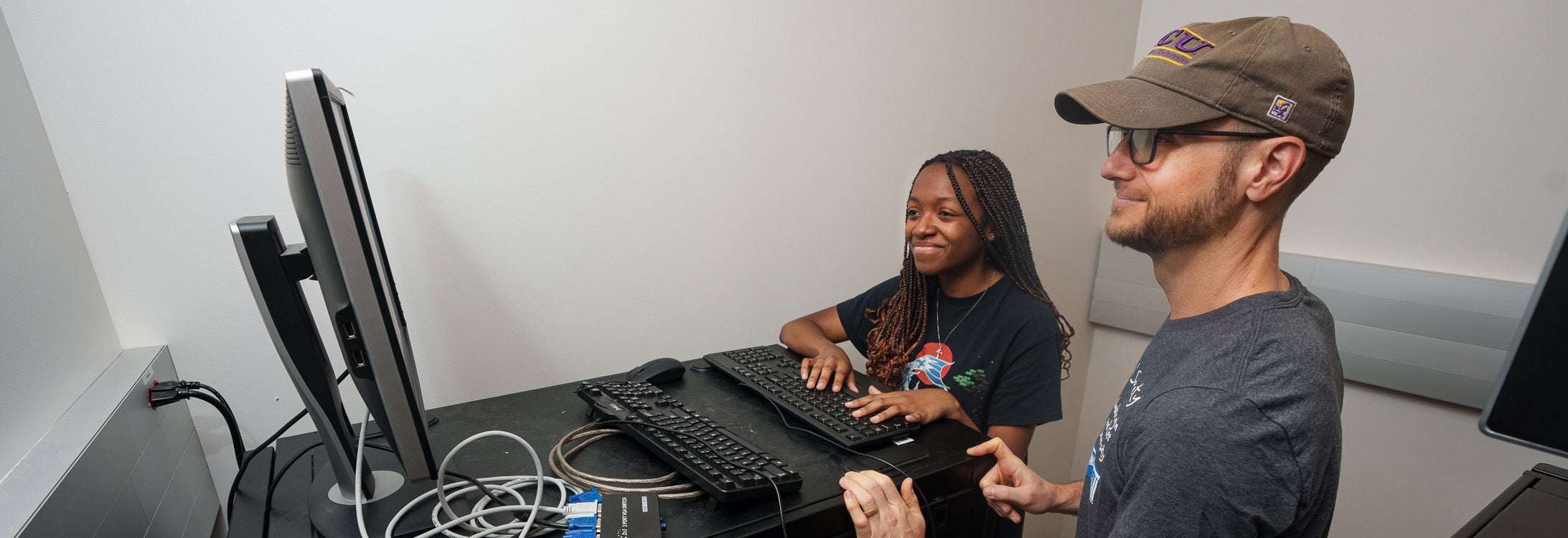NOT ALL SPIDERS
Analyzing the proteins of a once venomous spider
The ancestors of all spiders were venomous, but there are two groups of spiders today — one in the United States — that are no longer toxic.
East Carolina University’s Dr. Michael Brewer, director of biology graduate studies and associate professor of biology in the Thomas Harriot College of Arts and Sciences, and Hannah Pankey, a junior biology major at Fayetteville State University (FSU), are examining why one of these families still has the proteins that once made it venomous.
Pankey is one of 12 students participating in ECU’s STEM Summer Immersion Program — a 10-week, full-time, paid summer internship — funded by a $1.3 million North Carolina GlaxoSmithKline (GSK) Foundation grant.
During her internship, Pankey is working with Brewer to analyze spider venom protein sequences for evidence of natural selection relating to venom toxicity, behavior, life history and mating systems. The work may lead to potential agricultural and pharmaceutical benefits.

Pankey is learning basic computational skills and bioinformatic analyses, skills that easily extend to other areas of study, including human medical studies and toxicology.
For example, Brewer said spider venoms are currently used in pesticides, since they are designed to kill insects. Therapeutic venoms, such as certain scorpion venoms, are used in some cancer drugs, and the venom from a spider in Australia — administered nasally into the blood stream of stroke patients by paramedics who are first on the scene — has been shown to cause retention of brain tissue that would have died without the treatment.
Pankey is learning basic computational skills and bioinformatic analyses, skills that easily extend to other areas of study, including human medical studies and toxicology — an area she is interested in pursuing.
“As part of this program, Hannah is getting a true deep immersion into computational research,” Brewer said. “It is impossible to work in modern biology and not do some coding. So having access to these skills are not just a leg up anymore, they are a necessity.”
“I never thought I would get into coding,” Pankey said. “It is very interesting learning the language and seeing how much it can do.”
Special group of spiders
According to Brewer, all living spiders either are venomous or have vestigial venom glands, and only two groups of spiders no longer produce venom. One of these is a relic group found in Southeast Asia that is a sister to all other spiders. It looks like a tarantula or a trapdoor spider, but it is not closely related.
“You can look at their physiology and they have vestigial venom glands,” he said. “They still have fangs and holes in their fangs, but they just don’t produce venom.”
Brewer said that all spiders found in the U.S. are venomous except for one family — Uloboridae spiders, commonly known as orb weavers.
Because spiders can produce tens of thousands of different venom proteins, Brewer said he wonders what happens when spiders stop producing venom. Are the venom proteins still expressed? He said he has some preliminary evidence that the answer is yes, but then the next step is determining how they are different. Are they still being secreted? Are they being used in internal cellular physiology?
Therefore, this summer, Brewer and Pankey examined all the genes that are expressed in the uloborid spiders.
“Pankey will use available sequence data of genes that are expressed in the uloborid spiders to extract out the messenger RNA and turn it back into DNA and sequence it,” Brewer said. “So, we get the sequences of not only what is in the genome that can be made into venom proteins, but we also get the ones that are actively being expressed.”
If venom proteins are being expressed, Brewer said they can examine whether the proteins look meaningfully different from other spiders that still use them as a venom. He said they can look at how the venom proteins are different and which parts make it dangerous.
With the information they gain through their project, Brewer and Pankey may conclude that the uloborid spiders are using the venomous proteins, but perhaps for something other than what their ancestors used them — protection and defense. Brewer said they won’t be able to answer the question of what the proteins are used for with this project, but that it gets them started in that direction.
Pankey, who is considering furthering her education by pursuing a doctoral degree in toxicology once she completes her degree at FSU, said the ECU internship experience is beneficial. She may attend ECU for her graduate degree, and she wants to learn more computational biology and computer programming.
“It puts me in the life of being a researcher and helping me to decide if this is really what I want to do,” she said. “I hope to be able to apply this experience to my future experiments.”
During the 40-hour-a-week internship, Pankey participated in fieldwork, which is a big component of Brewer’s research, and she received some chemistry experience, which is helpful in studying venoms and in her potential career as a toxicologist.
